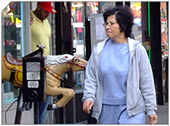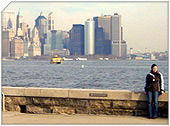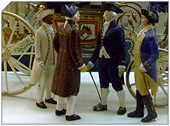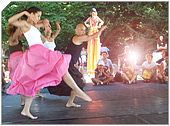Ellis Island, Manhattan, New York City
|
Getting Started
Index
NYC Neighborhoods
Manhattan
Brooklyn
Queens
Bronx
Staten Island
NYC Icons
Chrysler Building
Flatiron Building
Empire State Building
Safe NYC
NYPD
FDNY
NYC Weather
NYC Climate
NYC Weather Forecast
Winter Season
Spring Season
Summer Season
Fall Season
NYC History & Politics
New York City History
Tammany Hall and Politics
New York City Politicians
New York City Personalities
Culture of Gotham City
Culture of the city
Cultural diversity
City in popular culture
|
Ellis Island, at the mouth of the Hudson River in New York Harbor, was at one time the main entry facility for immigrants entering the United States in the late 19th and early 20th centuries. Ellis Island is within the boundaries of Jersey City, New Jersey but is legally part of New York under the 1834 treaty setting the boundary between the two states. However, due to landfill which has expanded the island's 1834 boundaries, the island is divided between New York and New Jersey. It is wholly in the possession of the Federal government as a part of Statue of Liberty National Monument, however, and is under the jurisdiction of the US National Park Service. According to the United States Census Bureau, the island, which was largely artificially created through the landfill process, has an official land area of 129,619 square meters, or 32 acres, more than 83 percent of which lies in the city of Jersey City. The natural portion of the island, lying in New York City, is 21,458 square meters (5.3 acres), and is completely surrounded by the artificially created portion. For New York State tax purposes it is assessed as Manhattan Block 1, Lot 201. Since 1998, it has also a tax number assigned by the state of New Jersey.
The Ellis Island Immigrant Station was designed by architects Edward Lippincott Tilton and William Boring. They received a gold medal at the 1900 Paris Exposition for the building's design.
History
Ellis Island takes its name from Samuel Ellis, a colonial New Yorker, possibly from Wales, who owned the island during the late 1700s and kept a tavern, serving sailors and local fishermen. Samuel Ellis was a local farmer and merchant.
The federal immigration station opened on January 1, 1892 and was closed in November 12, 1954, but not before 12 million immigrants, were inspected there by the US Bureau of Immigration (Immigration and Naturalization Service)(the estimates for immigrants processed there may have been as high as 20 million, but this is unsubstantiated). In the 35 years before Ellis Island opened, over 8 million immigrants had been processed locally by New York State officials at Castle Garden Immigration Depot in Manhattan. Many who were allowed entry settled in New York and northern New Jersey for at least their first few years in America, but left the area for inland and other coastal destinations in the USA and Canada. During the period 1910 to 1940, Angel Island (between Alcatraz and the Pacific Ocean in San Francisco Bay) was opened on the West Coast; there some 175,000 foreigners were inspected, mostly Chinese. Other immigration stations that were as prominent as San Francisco's (but much less active than Ellis Island) were located at New Orleans, Seattle, Boston, Philadelphia and Baltimore.
Ellis Island was one of 30 processing stations opened by the federal government. It was the major processing station for third class/steerage immigrants entering the United States in 1892; it processed 70% of all immigrants at the time. Wealthy immigrants that traveled first class and second class would get automatic entry into the United States. First they had to pass a six second physical examination. Those with visible health problems or diseases were sent home or held in the island's hospital facilities for long periods of time. Next they were asked 29 questions including name, occupation, and the amount of money they carried with them. Generally those immigrants who were approved spent from three to five hours at Ellis Island. However more than three thousand would-be immigrants died on Ellis Island while being held in the hospital facilities. Some unskilled workers and immigrants were rejected outright because they were considered "likely to become a public charge." About 2 percent were denied admission to the U.S. and sent back to their countries of origin for reasons such as chronic contagious disease, criminal background, or insanity.
Writer Louis Adamic came to America from Slovenia in southeastern Europe in 1913. Adamic described the night he spent on Ellis Island. He and many other immigrants slept on bunk beds in a huge hall. Lacking a warm blanket, the young man "shivered, sleepless, all night, listening to snores" and dreams "in perhaps a dozen different languages".
After 1924, with demands for further immigration restrictions, "The Quota Laws" would be passed and they would have a major impact on immigration. After they were passed Ellis Island was used only sporadically for immigration. It would be mostly used for detainees and refugees. Italians were detained, Japanese were interned, but the major group to be detained were German Americans during World War II falsely accused of being Nazis. The United States would begin processing immigrants in the embassies and consulates of the emigrant country.
As with all historic areas administered by the National Park Service, Ellis Island, along with Statue of Liberty, was listed on the National Register of Historic Places on October 15, 1966.
Today Ellis Island houses a museum reachable by ferry from Liberty State Park in Jersey City, New Jersey and from the southern tip of Manhattan in New York City. The Statue of Liberty, sometimes thought to be on Ellis Island because of its symbolism as a welcome to immigrants, is actually on nearby Liberty Island, which is about 1/2 mile to the South.
Ellis island was also known as "The Isle of Tears" or "Heartbreak Island." Some immigrants were sent back to their countries and did not become U.S. citizens after a long travel to Ellis Island.
|
New York City Search
Quick NYC
|
|
|
 How safe is New York City?
How safe is New York City? Contrary to popular belief, the City consistantly ranks in the top ten safest large cities in the United States. The NYPD is the largest municipal police force in the world and has it's own Movie/TV Unit. |

New York has a humid continental climate resulting from prevailing wind patterns that bring cool air from the interior of the North American continent. New York winters are typically cold with moderate snowfall.  New York Weather Forecast New York Weather Forecast |

New York's two key demographic features are its density and diversity. The New York City metropolitan area is home to the largest Jewish community outside Israel. It is also home to nearly a quarter of the nation's South Asians, and the largest African American community of any city in the country.  Ethnic composition Ethnic composition |

New York Newspapers
 
|



 New York Weather Forecast
New York Weather Forecast
 Ethnic composition
Ethnic composition


















